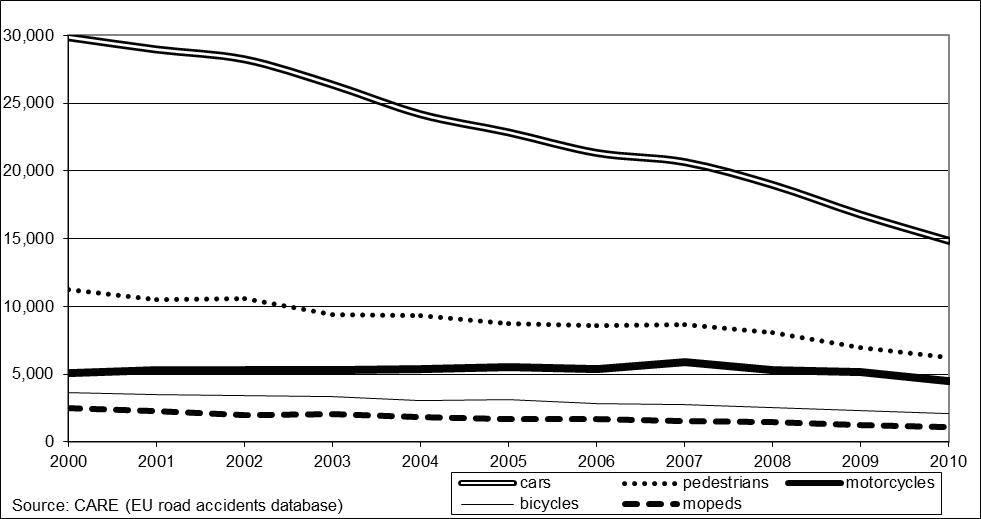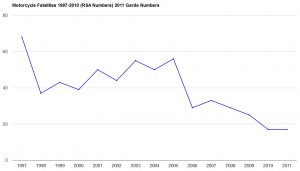Back in July of 2010, MAG Ireland reported that the EU Commission had set it’s sights on reducing motorcycle casualties. We went on to highlight the major points of the EU statement which included proposals for;
- Mandatory Advanced Braking Systems
- Updated anti-tampering measures (i.e. you cannot modify your bike)
- Extended roadworthiness testing (i.e. an NCT style annual bike test)
The Type Approval proposals, currently working their way through the IMCO Committee, have already gone some way down this road with ABS set to become mandatory on all bikes over 125cc while arguments continue as to its cost and benefit on smaller bikes. Equally, we’re all aware that the current Type Approval text allows for anti-tampering measures in the as yet unwritten delegated acts (despite there being no proof that tampering is in any way a quantifiable problem).
We know that there is significant discussion going on around all of these issues amongst the members of the IMCO Committee ahead of the planned vote which has recently been put back to 3rd July next. Our friends over at righttoride.eu have an excellent post on this aspect here: http://www.righttoride.eu/?p=9284
It is against this backdrop that last Thursday, 29th March, EU Transport Commissioner Siim Kallas was quoted in a Press Release by the EU Commission as follows;
At EU level, I intend also to target specifically fatalities on motorcycles in 2012, we need to see the current trend reversed and these deaths start to fall.
The press release (quoted at the bottom of this post) then goes on to cover all the same stuff we reported on back in 2010. For those of you who missed it two years ago, here is what the Commission proposes as part of it’s renewed focus on motorcyclists;
7. A new focus on MotorcyclistsThe Commission will focus particularly on motorcycles and other “powered two wheelers.”(PTW) While other vehicle transport modes have shown significant decreases in fatalities and serious injuries over time, those for PTW riders have exhibited much lower decreases or remained even static.At European level measures for powered two wheelers will be proposed:
|
Back in the Summer of 2010 we said;
MAG Ireland, like our colleagues in Northern Ireland and the UK and Europe, are dismayed – though not surprised – to see that the EU Commission ignore the real experts in the field, and revert to type by hauling out yet more unproven and expensive proposals that clearly demonstrate a stubborn refusal to accept the facts as presented by people who actually ride motorcycles in the real world.
That’s still our view today, almost two full years later, and despite the ongoing situation around the proposed Type Approval regulations which if passed as they stand will implement some of the technical “solutions” sought by Commissioner Kallas.

EU Commissioner Siim Kallas (Image Credit: EU Commission)
Ultimately, the statement by the Commission which we quote below is simply a re-hash of what they said back in 2010. What makes this noteworthy is the timing. Why has Commissioner Kallas reminded everyone of the “New focus on Motorcyclists” just as the formal discussions around the Type Approval regulations are heating up?
Another aspect of this statement which appears almost calculated to rile us as riders is the line that says;
“The problem of motorcycles – where fatalities have still not fallen after more than a decade – still persists.”
MAG Ireland has consistently pointed out that tackling any motorcycle related issue from the standpoint of motorcycling being a “problem” which needs some sort of “solution” is doomed to fail because it completely ignores the reality that most motorcycle accidents involving another road user are the fault of that other road user. In fact;
- Motorcyclists are already lowering their casualty figures by boosting their skill levels with training.
- To reduce them further requires other road users to become better trained.
MAG Ireland has consistently promoted training and awareness measures as the only proven way to reduce casualties amongst motorcyclists.
The continued bias towards technical measures (ABS, PTI, anti-tamper, etc.) at the expense of training and awareness amongst all road users is a classic case of Brussels having mis-diagnosed the problem. For example, we already know that few motorcycles fail PTI tests and the MAIDS study tells us that it’s a factor in less than 1% of cases, yet the EU continues to focus on technical measures like PTI which will have little or no impact on rider safety.
In trying to solve the ‘problem’ and make us ‘safer’, the EU has “looked but failed to see” the root cause – faults in other road users behaviour.
Text of the EU Statement.
Source: http://europa.eu/rapid/pressReleasesAction.do?reference=IP/12/326&format=HTML&aged=0&language=EN
|
Progress in cutting EU road deaths falls to 2% in 2011 Brussels, 29 March 2012 – Progress in cutting road fatalities significantly slowed last year (to -2%) compared with a very promising EU-wide reduction throughout the last decade (on average -6%), according to new figures published today by the European Commission. Worse still, some EU Member States, like Germany and Sweden, who have very strong safety records, now show a significant increase in deaths. In other Member States, like Poland and Belgium – already lagging behind in road safety – the number of deaths went up. The problem of motorcycles – where fatalities have still not fallen after more than a decade – still persists. Vice-President Siim Kallas, with responsibility for transport, said, “These figures are a wake-up call. This is the slowest decrease in road deaths in a decade. 85 people still die on Europe’s roads every day. This is unacceptable. We will need to sharply intensify efforts at EU and national level to reach our goal of cutting road fatalities in half again by 2020. I am writing to ministers in all Member States to ask for information about national road safety enforcement plans for 2012. I want to be reassured that even in tough economic times this important work, which is so central to road safety, is not being scaled back. At EU level, I intend also to target specifically fatalities on motorcycles in 2012, we need to see the current trend reversed and these deaths start to fall.” The attached table – “road fatalities per country” – shows progress since 2001, with EU-wide figures and a breakdown per country. It includes the most recent figures for 2011. Over the last decade, under the Road Safety Action Plan 2001-2011, major progress has been achieved. Road fatalities were cut by almost 45% and more than 125,000 lives were saved. EU road deaths decreased by on average 6% each year. And in some years the decrease has been as much as 11% (2010). EU road safety action plan 2011-2020 In July 2010 the Commission adopted challenging plans to reduce the number of deaths on Europe’s roads by half in the next 10 years. Initiatives proposed in the “European Road Safety Policy Orientations 2011-2020” range from setting higher standards for vehicle safety, to improving the training of road users, and increasing the enforcement of road rules. The Commission is working closely with Member States to implement this programme. The road safety action plan sets out a mix of initiatives focussing on making improvements to vehicles, infrastructure and road users’ behaviour. There are seven strategic objectives:
Detailed measures for each strategic objective are listed in MEMO/10/343. See also: MEMO/11/483 |
MAG Ireland note: The source contains further information including a table of fatalities broken down by country.
MAG Ireland’s original post on this topic can be found here: https://www.magireland.org/2010/eu-fema/eu-road-safety-mandarins-announce-new-focus-on-motorcyclists/
The graph at the bottom of the EU Commission statement is the basis for the statement released on Friday, and we reproduce it here for your information.
For Comparison, here are the Irish fatality rates for motorcycle riders and pillion passengers from 1997 to 2011. There have been big reductions since 2005 which correlates with the introduction of the Axa/Quinn assessments and a surge in the numbers taking pre and post test training since the middle of the last decade.
The bottom line: MAG Ireland has consistently worked to improve safety for and amongst riders for well over a decade. MAG Ireland was instrumental in setting up the Irish Rider Training Association to provide affordable high quality training at a time when the Government completely ignored the deplorable lack of regulation in the driver training sector. MAG Ireland co-authored the RSA’s “This is your bike” booklet, and continues to campaign for better awareness of motorcyclists amongst other road users. We believe that prevention is better than cure. We know from direct experience that training, and particularly advanced training, is effective in reducing motorcycle casualties. We also know that many of the technical measures proposed such as Periodic Technical Inspection and Mandatory High Visibility Clothing are not.
Footnote: Our friends in Northern Ireland’s Right to Ride have published an excellent post on this topic which you can read on their web site at: http://www.righttoride.eu/?p=9303
Not a MAG Ireland member? Why not show your support?
Donate to MAG Ireland – Become a MAG Ireland Member

